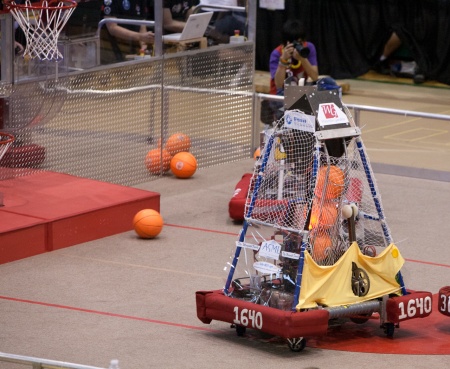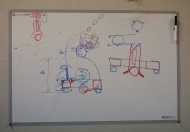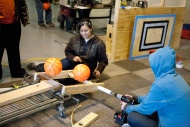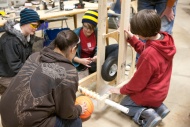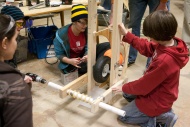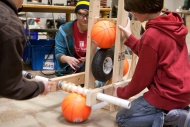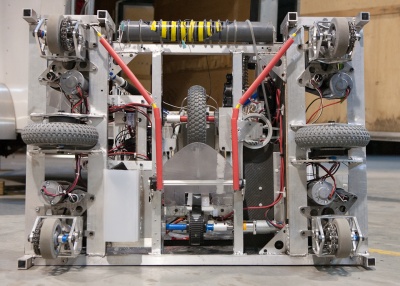DEWBOT VIII Ball Collection and Storage
From DEW Robotics
Ball collection and storage requirements for Rebound Rumble are:
- Quickly and reliably pick balls off the playing field
- Ability to top load at the Inbound Station
- Able to possess three balls
- Able to prevent possession of more than three balls
- Fast transport of balls to the shooter
Ulitmately, this system took the form of:
- A 19" wide beater bar on the wide front side of the robot; pulling balls in and keeping them there;
- An alternative top hopper feed; mechanism still works but hopper has degraded over time due to non-use;
- A funnel to guide balls from the 19" beater bar to the narrow lift entrance;
- A lift entrance, comprising: a) a driven Lift Wheel; b) a static pinch bar; and c) a flexible scoop; and
- An angled lift, having a posterior lift belt and two anterior lift rails; (4) IR sensors register ball positions within the lift assembly; the lift is capable of storing (3) balls and tracking the number of balls stored; the lift top communicates directly with the shooter.
Key Technical Challenges
- The strategic decision to cross the barrier together with the drive-train decision to use Pivot Drive again leads to the practical requirement to keep all rigid ball lift mechanisms above 4.5" above grade (at least while crossing the barrier).
- The strategic decision to enable 3-robot bridge balancing led to the decision to be able to drive the robot in the wide orientation (the desire to also drive in the long orientation to facilitate barrier crossing influenced the Pivot drive-train decision). This was seen to enable ball collection due to the wider ball entry orifice, but...
- ...Funneling down the balls collected with a 19" Beater Bar to a discrete ball lift in the short distance allowed by a wide chassis orientation while avoiding rigid elements lower than 4.5" is a clear challenge.
- Loading the lift should be automated and not require direct human control.
- We want to top load and floor load. Is this one mechanism or two?
- 1640 tradition is to build scoring mechanisms and particularly pick-ups, lifts and shooters which are too slow for champion robots. We sought to change this.
The Barrier Crossing and Drive-train decisions (which were not bad decisions) are clearly expensive. Ball Collection and Lift was where this cost was to be paid.
Concepts
Some key concepts considered were:
- The wide orientation collection was seen to be an obvious benefit (but, in retrospect, I wish more though was given to this and the funneling of balls from a wide collector to a narrow lift).
- Ball pick-up & lift was inspired strongly by Team 293's 2006 (Aim High) robot1. The model mechanism was not actually a ball pick-up mechanism, but a lift only. This mechanism comprised a pair of large-diameter (approx 10 in) pneumatic wheels driving balls within an S-shaped guide to a shooter.
- A pinch bar at an elevation no lower than 4.5 in, together with a lower lift wheel also no lower than this elevation, could pinch a ball between them to lift it off the ground without having any rigid portion below 4.5 in elevation (thereby clearing the barrier). The pinch bar and lift wheel may be counter-rotating or alternatively the pinch bar may be non-rotating.
- A Geneva Wheel could take the place of 293's top pneumatic wheel, thereby providing clear indexing.
- The bottom lift wheel could feed a linear belt-driven, guide rail constrained lift directly
- Non-contact IR sensors could provide ball indication at critical positions.
- Such indication could automatically control the lift; and
- Such indication could also prevent possession of more than three balls by reversing the beater bar.
Prototypes
[[image:DB8_ball_path.jpg|left|300px|thumb|DEWBOT VIII ball path
- 1Wilczynski, V & Slezycki, S, "FIRST Robots, Behind the design - Aim High", Rockport Publishers Inc., 2007, pp 238-243
